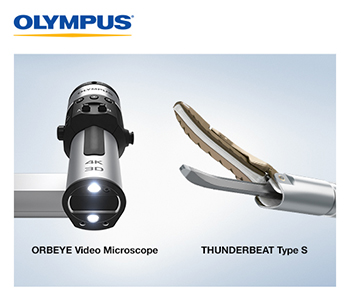Olympus ORBEYE Video Microscope and THUNDERBEAT Energy Device Enable Lifesaving Transplant
Liver Transplantation Is on the Rise – World Hepatitis Day, July 28, Gives Cause to Celebrate Advancements

The combined surgical solutions of the Olympus ORBEYE® video microscope and THUNDERBEAT advanced energy surgical device have been used successfully in an infant liver transplantation at Holtz Children’s Hospital at the University of Miami/Jackson Memorial Medical Center.
CENTER VALLEY, Pa., (July 31, 2019) – Olympus, a global technology leader in designing and delivering innovative solutions for medical and surgical procedures, among other core businesses, announced today that the combined surgical solutions of the ORBEYE® video microscope and the THUNDERBEAT advanced energy surgical device have been used successfully in an infant liver transplantation at Holtz Children’s Hospital at the University of Miami/Jackson Memorial Medical Center. Doctors from the Miami Transplant Institute (MTI), an affiliation between Jackson Health System and UHealth – University of Miami Health System, led the surgery.
In this world’s-first case using both of these groundbreaking technologies, baby boy Michael Angelo was treated for a rare genetic, life-threatening disease that appears in infants, biliary atresia, receiving a piece of a liver from a much larger donor. Typically doctors would not take the risk on a baby of Michael’s size at 4kg (8.8 lbs) — to date they had only performed surgeries on babies of 6kg (13.2 lbs) or larger — but the new technologies available gave the team confidence that the transplant could be successful.
The successful surgery was led by UHealth transplant surgeon Rodrigo Vianna, director, Miami Transplant Institute and chief of liver, intestinal, and multivisceral transplant, Akin Tekin, MD, UHealth’s liver, intestinal and multivisceral surgeon, Thiago Beduschi, MD, UHealth surgical director, living donor liver program, and Gennaro Selvaggi, MD, FACS, UHealth transplant surgeon, alongside a multidisciplinary team.
“We had to cut just a piece of a liver from a 2-year-old, so really it was a piece of liver that was probably 100 or 150 grams,” said Dr. Vianna. “And then we were left with very tiny vessels and structures to reconstruct.”
The ORBEYE 4K-3D enables the surgeon and surgical team to view optical and high-resolution anatomical digital images on a 55-inch monitor, in detail not previously available without the use of microscope eyepieces. Combined with the THUNDERBEAT advanced energy platform, new levels of efficiency and precision can be achieved during transplantation. THUNDERBEAT provides surgeons the ability to access advanced bipolar and ultrasonic energy simultaneously and without instrument exchange, enabling significantly faster transection, more precise tissue dissection and reliable 7mm vessel sealing. Both ORBEYE and THUNDERBEAT provide the potential to reduce surgeon fatigue during complex and lengthy surgeries.
“Liver cancer, NASH and hepatitis C have contributed to a rising need for liver transplantation, in an environment that is already limited in terms of donor organs,” said Dr. Thiago Beduschi, Associate Professor of Surgery and Director of Living Donor Liver Transplant Program at University of Miami Miller School of Medicine, Miami Transplant Institute, Jackson Health System. Although Michael’s surgery was not a live liver transplant, it was a novel procedure in many other ways, from the baby’s size, to the degree to which we had to reduce the size of the donor liver, to the combined technologies that we used to achieve success.”
The liver is the second most commonly transplanted major organ, after the kidney. In 2018 in the United States, 8,250 patients received a liver transplant, a two percent increase over 2017.i As of June 30, 2016, nearly 80,000 adults were living with a functioning liver graft.ii Less than five percent of U.S. liver transplantations are from live donors.iii
“This past Sunday’s July 28 was National World Hepatitis Awareness Day, a good reminder to think about liver health,” said Randy Clark, President, Medical Systems Group, Olympus Corporation of the Americas. “Although no one wants to be a on a transplant list, we are proud to be a company that can give new hope to those patients who could benefit from transplantation because of liver disease.”
Baby Michael remained in the pediatric intensive care unit at Holtz Children’s Hospital for seven weeks for recovery and was recently discharged with weekly clinic visits. The healthy 9-month-old baby returned home to Tampa in June for the first time since January. During a press conference at Jackson Memorial Hospital on Thursday, June 6th, his parents spoke to media and thanked Michael’s medical team for taking a chance on their child.
# # #
About Olympus Medical Systems Group
Olympus is a global technology leader, crafting innovative optical and digital solutions in medical technologies; life sciences; industrial solutions; and cameras and audio products. Throughout our 100-year history, Olympus has focused on being true to society and making people’s lives healthier, safer and more fulfilling.
Our Medical Business works with health care professionals to combine our innovative capabilities in medical technology, therapeutic intervention, and precision manufacturing with their skills to deliver diagnostic, therapeutic and minimally invasive procedures to improve clinical outcomes, reduce overall costs and enhance quality of life for patients. For more information, visit medical.olympusamerica.com.
About the Miami Transplant Institute
MTI was ranked the second largest transplant center in the United States by the Organ Procurement and Transplantation Network/United Network for Organ Sharing (OPTN/UNOS). During 2018, MTI performed 681 transplants, with pediatric liver cases ranking fourth in the nation. It is one of the largest and most comprehensive transplant programs in the United States for both adults and pediatrics.
i United National Network for Organ Sharing (UNOS). Data, UNOS Web site, Available at https://unos.org/data/, Accessed: June 24, 2019.
ii Kim WR, Lake JR, Smith JM, Schladt DP, Skeans MA, Harper AM, et al. OTNY/SRTR 2016 Annual Data Report: Liver. AmJ Transplant. 2018 Jan. 18 Suppl 1:172-253.
iii Organ Procurement and Transplantation Network, https://optn.transplant.hrsa.gov/data/view-data-reports/build-advanced. Accessed: Jun 24, 2019.


































